4 Manufacturing in Space (Jackson & Joseph)
Student Learning Objectives:
- The student will learn the potential of manufacturing in space, on Earth and on the International Space Station (ISS).
- The student will learn the potential of manufacturing replacement parts in space, recycling in space, printing spacecraft and use of resources on planetary surfaces.
- The student will learn the difference between circular economics and sustainability and the need for manufacturing in space as an application of circular economic principles.
Introduction
Manufacturing in space is becoming a strategic aspect of endeavor that aims to produce materials that cannot be manufactured on Earth for a variety of reasons and where their processing damages the Earth’s environment. Prior missions to establish a scientific basis for manufacturing in space developed in the 1950s with the foundations of studying materials in microgravity environments commencing with the Mercury and Gemini programs progressing to welding and casting in space during the Apollo and Skylab era (Figure 4-1). The Space Shuttle and Mir enterprises progressed the initial work with the Spacelab and the International Space Station (ISS). The focus was on the processing of materials without containers, welding, and crystal formation (solidification), and in fact, all the characteristics needed to realize additive manufacturing as a process to be used in space (Volz 2014).
In recent years, a US government-led consortium known as ‘America Makes’ is fully supported by NASA (www.nasa.gov) and is creating initiatives associated with ‘in-space manufacturing’ with NASA leading the charge on all aspects of manufacturing in space (https://www.americamakes.us/). Parallel development of manufacturing in space is also occurring in the European Union (EU) as part of the strategic agenda of the EU focusing on additive manufacturing for the aerospace sector (http://www.rm-platform.com/).
Figure 4-1 Long Duration Microgravity Materials Science Research
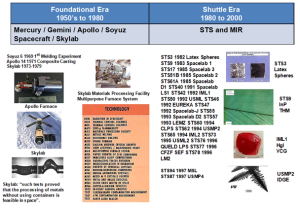
Source: Courtesy of NASA.
The EU’s focus is primarily on materials, technology, engineering, and the circular economy/sustainability via the Fraunhofer Institutes (AM Sub-Platform 2013, EU Powder Metallurgy Association 2014). The European Space Agency (ESA) is focused of additive manufacturing in space to develop replacement parts for the ISS. The EU’s Additive Manufacturing Aiming Towards Zero Waste and Efficient Production of High-Tech Metal Products (AMAZE) project involved in-space applications as a core area across the whole of the EU (https://cordis.europa.eu/project/id/313781). ESA is funding in situ additive manufacturing on planetary habitats such as the Moon and asteroids using methods developed in the US. However, the development of manufacturing standards in space and international cooperation between space agencies needs to be established to eliminate duplication owing to the cost of manufacturing in space (Volz 2014).
Manufacturing standards
At least 10,000 ASTM standards (www.astm.org) have been developed for product safety, quality, market access, trade, and consumer confidence. The International Organization Standardization (ISO) (www.iso.org), is also developing technical product standards. Standards specifically for additive manufacturing are being jointly developed by Committee F42 of the ASTM and Technical Committee 261 of ISO.
The variation in standards is in areas of terminology, processes and materials, test methods, and design and data formats. The development of standards by ASTM/ISO for in-space applications are qualification and certification methods, design guidelines, test methods for characterizing raw materials, test methods for mechanical properties of additively manufactured parts, material recycling guidelines, standard protocols for testing, standard test artifacts, and requirements especially for additively manufactured parts (Prater et alia 2019).
Harmony of standards
Considering general manufacturing, standards are already established for Earth-based processing. ASTM has specific terminology for fundamental additive manufacturing. The seven categories given for additive manufacturing technologies under ASTM Standard F2792-12A are vat photopolymerization, material extrusion, material jetting, binder jetting, powder bed fusion, sheet lamination, and direct-energy deposition. However, for terrestrial manufacturing, standards will need to be established prior to large scale in-space additive manufacturing activities (Nafisi et al. 2022).
Manufacturing on Earth
Manufacturing applications (especially additive) are increasing for many aerospace applications. Lockheed Martin additively manufactured waveguide brackets for microwave communication components for NASA’s Juno spacecraft launched in 2011 (Figures 4-2 and 4-3). Other parts are being manufactured using additive manufacturing techniques such as rocket engine injectors, entire jet engines, components of engines, CubeSats and small satellites (Schmuland et al. 2013, Gradl et al. 2022).
Figure 4-2 The Juno spacecraft includes additively manufactured space system components
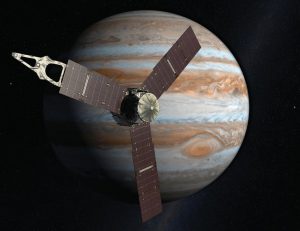
Source: Courtesy of NASA/JPL (https://www.jpl.nasa.gov/)
The Fused Deposition Modeling (FDM) technique is, and additive manufacturing process used by Aurora Flight Sciences to manufacture drone systems and components with active sensors embedded into 3D-printed wings and printed heat exchangers using novel materials (Gradl et al. 2022). Airbus is using 3D printing techniques to produce fully functional metallic prototype of the airframe and propulsion system for a drone aircraft and there are many other examples that show additive manufacturing/printing is able to create complex shapes that are difficult to produce with traditional casting or machining processes (Patankar 2018, Gradl et al. 2022).
Figure 4-3 Additively manufactured waveguide brackets for the Juno spacecraft
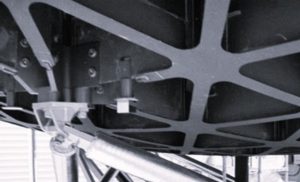
Source: Courtesy of Lockheed Martin (www.lockheedmartin.com).
Additive manufacturing creates high value materials and combinations of materials to direct specific product material properties with gradient coatings. NASA’s Jet Propulsion Laboratory (JPL) is using printing technology to create gradient structures focusing on specific physical characteristics, rigidity, and/or electrical and thermal properties (Hoffman et alia 2013) that are tailored for performance under various structural load and temperature conditions (https://www.jpl.nasa.gov/). The gradient-metallic alloy mirror assembly developed at JPL is a perfect example of using printing techniques to create gradient engineered materials (Figure 4-4).
The components manufactured this way illustrate how components can be enhanced when exposed to the harsh and complex physical conditions of space (Bhudiya et al. 2022). Additive manufacturing creates less waste compared to traditional manufacturing processes and cost savings are significant (Volz 2014). However, there are still issues with the process owing to the microstructural integrity and reliability. Research in the form of hybrid additive manufacturing systems that combine additive manufacturing with direct-writing technologies that allow embedded structures to be produced in three dimensions. The integration of electronics with 3D printed structures allows flexibility for use in complex environments in space.
Figure 4-4 (a) An isotherm of the Fe-Ni-Cr ternary phase diagram showing different gradient compositions. The lines represent composition gradients between 304L stainless steel and Invar 36, a simplified Inconel 625 alloy and NiFeCr alloy; (b) An isogrid mirror fabricated using a 3D plastic printer; (c) a fabricated part using laser-engineered net shaping (LENS). The mirror surface of Invar 36 and the isogrid backing is a gradient alloy that transitions from Invar 36 to stainless steel; (d) A gradient alloy mirror assembly with a metal-coated glass mirror attached to the Invar side of the assembly using epoxy; (e) Test samples of a Ti-V gradient alloy being fabricated by LENS; (f) The compositions of the gradient mirror assembly in (d), and (g) hardness and thermal expansions across the gradient mirror assembly. (http://www.techbriefs.com/component/content/article/5- ntb/tech-briefs/materials/17446.
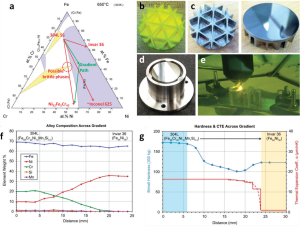
Source: Images courtesy of NASA/Jet Propulsion Laboratory/California Institute of Technology).
The benefits of manufacturing ground-based aerospace applications are significant. However, certain disadvantages need to be addressed for use in space environments and include the cost of operation (equipment, maintenance, and materials); machine performance (size, speed, reliability, repeatability, and reproducibility); and availability/use of materials in space environments.
Manufacturing of space devices on Earth
The first use of additive manufacturing techniques for space applications is the development of CubeSats (https://www.cubesat.org/), the first being launched into low Earth orbit (LEO) in 2003. There are more than 4000 of these small (10 cm × 10 cm x 10 cm) satellites have now been placed in LEO (nanosats.eu, 2022). An example of an additively manufactured CubeSat is shown in Figure 4-5. The low cost and simplicity of CubeSats is highly advantageous for developing space science on the small scale. CubeSats were built using traditional spacecraft technologies and are built with a wide range of assemblies and external features produced using additive manufacturing materials/processes. The features produced can control on-board systems including power, communications, propulsion systems, thermal control, attitude control, digital systems, and instrumentation (Russell 2017).
PrintSat (http://www.ssel.montana.edu/printsat.html) was built to demonstrate the manufacture of space structures and mechanisms in a university environment. The satellite structure is composed of polyamide carbon-filled structures used for terrestrial applications. The payload elements include a single-chip hybrid radiation micro dosimeter, load cells, and a surface resistivity sensor to measure the surface resistivity of its nickel plating. The system was designed by students of the Space Science and Engineering Laboratory using standard engineering software and hardware. Flight testing was conducted to NASA standards then launched aboard a small vehicle known as Super Strypi as part of Sandia’s space program (www.sandia.gov). This type of space education is clearly achievable using standard equipment/software and associations with government laboratories and agencies.
Manufacturing construction in space
Manufacturing assembly in space started at the beginning of the space program. The effort involved the integration of large and complex components such as space station modules, rather than manufacturing of sub-assemblies/components in space. Space operations required launching fully integrated spacecraft or connecting sub-assemblies in orbit with robots and with human support. Structures and objects were made on the ground and launched into space and assembled using conventional methods. The Soviet space program performed in-orbit welding, and in-space welding has been studied by a US aerospace contractor. NASA employed supporting technologies associated with welding processes and the ISS was an assembly and integration project that was manufactured on Earth. However, there were attempts at in-space manufacturing of construction materials in the mid- 1970s, when NASA built the ‘Space Fabrication Demonstration System’ capable of assembling triangular aluminum trusses. The system was tested at NASA Marshall Space Flight Center (MSFC) in Alabama, where NASA considered using lunar regolith or Martian soil for the construction of structures. However, the project did not continue.
Figure 4-5 NCUBE2 CubeSat integrated with the ESA satellite SSETI-Express
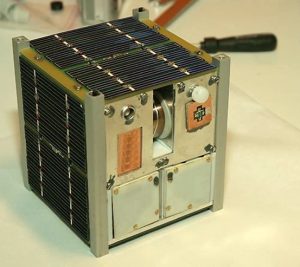
Source: Courtesy of Bjørn Pedersen, NTNU, Norway.
Materials science and manufacturing aboard the ISS
The development of materials science aboard the ISS has prompted the development of using additive manufacturing processes in space (Momeni et al. 2022). Initial studies on microgravity showed that diffusion-controlled growth is the dominant mechanism of solidification promoting uniform microstructures as shown in Figure 4-6. Figure 4-6 shows the differences between anisotropic dendrite formation in Pb-Sb alloys and segregation channels in Pb-Sn alloys grown on Earth to those formed in space. Space grown alloys show uniform microstructure due to reduced thermal and solute convection flows (Volz 2014).
Figure 4-6 Microgravity Reduces Thermal and Solute Convection (Volz 2014)
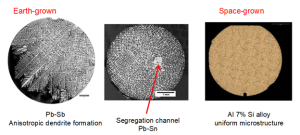
Source: Courtesy of NASA.
Microgravity also minimizes sedimentation and buoyancy of mixed materials, which promotes uniform particle distributions that leads to understanding of coarsening mechanisms and sintering (Figure 4-7) (Volz 2014). The systems used on the ISS to conduct materials science experiments focus on the use of a materials science glovebox, a SUBSA vertical gradient furnace with transparent growth zone, a PFMI low temperature furnace for solidification and remelting of transparent materials and a CSLM quench furnace for studying coarsening in metals (Figure 8).
In addition to the equipment on the ISS shown in Figure 4-8, a Low Gradient Furnace (LGF) and a Solidification Quench Furnace (SQF) also operate on the materials science rack on the ISS with cartridges provided by ESA (Figure 4-9). These pieces of equipment provide the laboratory equipment needed to understand the basics of manufacturing in space (Volz 2014).
Figure 4-7 Microgravity Minimizes Sedimentation and Buoyancy (Volz 2014)
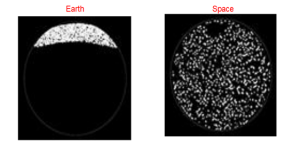
Source: Courtesy of NASA.
In 1999, Cooper and Griffin of NASA MSFC helped publish a report that referred to direct manufacturing and stated that in remote locations such as the Moon or Mars, direct fabrication (manufacturing) could be used to produce items on location (NRC 2000). The report explained how additive manufacturing in microgravity space demonstrated the benefits of the fused deposition modeling (FDM) technique to quickly produce replacement components or repair broken hardware on the Space Shuttle (SS) or on the International Space Station (ISS).
Cooper and Griffin conducted many laboratory experiments and KC-135 low-gravity aircraft experiments to demonstrate the capability of FDM equipment to fabricate in a microgravity environment. Cooper and Griffin developed a hardware implementation plan using FDM for further experiments aboard the ISS. They proposed using an ISS FDM device with a 10 cm × 10 cm × 10 cm working volume, total mass of approximately 45-65 kg, physical envelope of 0.45 m × 0.5 m × 0.6 m using peak power of 300 W with an air cooling of 150 W (Cooper and Griffin 2003).
Additive manufacturing holds the potential to extend traditional manufacturing capabilities to physical scales currently unobtainable with current spaceflight hardware construction practices (Korkut and Yavuz 2022). Manufacturing in space allows construction of structures and subsystems fully optimized to operate in the zero-gravity environment with volume-to-mass efficiencies that may revolutionize future approaches to design (Prater et alia 2018, 2019).
Figure 4-8 Materials Science Facilities on the ISS: Materials Science Glovebox (MSG) Facilities (Volz 2014)
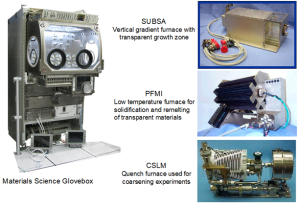
Source: Courtesy of NASA
Manufacturing in Space
Manufacturing in space is a very useful way of creating replacement parts and systems. The percentage of hardware failures on the International Space Station (ISS) involve polymeric and composite materials (~ 30%) that can be repaired using additive manufacturing techniques on board the ISS. NASA has developed several ways to achieve this. Contracts with ‘Made In Space, Inc.’ (www.madeinspace.us) to provide extrusion-based additive manufacturing in microgravity environments on board the ISS were granted. Once printed, an optical scanner is used to verify the integrity of parts made with a view to create procedures to use metals and combinations of materials (Prater et alia 2019).
Figure 4-9 Materials Science Facilities on the ISS: Low Gradient Furnace (LGF) & Solidification Quench Furnace (SQF) (Volz 2014)

Source: Courtesy of NASA.
In addition to additive manufacturing, other forms of traditional manufacturing are envisaged such as container-less melting of metals (Figure 4-10), mixing of liquids for pharmaceutical production and the bulk solids processing of liquids and solids. Additive manufacturing in space presents new opportunities for recycling. Recycling material on the ISS has a significant impact on ISS operations. Traditionally, astronauts assign waste to robotic spacecraft (Russian Progress and the Orbital Sciences’ Cygnus) for disposal. This is achieved by detaching from the ISS and burning up in the upper atmosphere of the Earth. However, using recycled materials would eliminate that operation. Component/system creation and recycling allows one to launch feedstock to ISS instead of hardware (Prater et alia 2018).
The microgravity environment enables accurate measurements of material properties such as viscosity and surface tension, facilitates nucleation studies, increases the size of crystals that can be grown container-less and reduces defect densities from contact with container walls (Figure 4-10).
Figure 4-10 Microgravity Allows Container-less Processing to Manufacture Items (Volz 2014)

Source: Courtesy of NASA.
Manufacturing hardware enables the production of low-mass systems thereby reducing launch and storage burdens. Antennas, booms, and panels are designed for launching and their size and shape are limited in addition to their functionality and scale. Manufacturing in space and orbital construction enable deployment of systems that do not conform to weight and volume constraints. Systems include mirrors, gossamer structures, antennas and arrays, reflectors, trusses and much more (Kovalchuk et al. 2022).
Tethers Unlimited (https://www.tethers.com/) is a company that provides launchable materials in the form of spools of thread to form large truss-based structures such as solar arrays and antennas in space. Other applications such as star shades to block light/heat from stars allow space-based telescopes to image exoplanets around stars. The use of a large spider-like robot that can extrude long beams of thread and join large structures together is highly attractive for space exploration activities and is known as ‘SpiderFab’ (Figure 4-11).
Additive manufacturing in space enables the production of entire subsystems and systems including the production, assembly, and launch of sensor-based CubeSats from the ISS and other platforms in orbit (Stewart et al. 2022). In-space satellites deployed as swarms are not inconceivable. The Automated Manufacturing Facility on the ISS and CubeSat platforms could provide swarms of satellites. The swarm could have a range of capabilities and act as a fully functional satellite system.
Figure 4-11 ‘SpiderFab’ is a combination structural elements and multi-dexterous robots that can control and manipulate structural elements
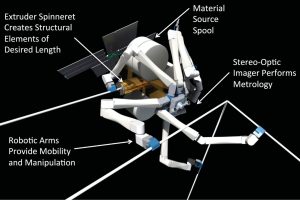
Source: Courtesy of Tethers Unlimited.
The concept of a fabrication laboratory (fab lab) was developed at the Massachusetts Institute of Technology. A typical fab lab is equipped with flexible manufacturing systems and would be able to manufacture what is needed without providing it from Earth. Free-flying fab labs for manufacturing in space is a distinct possibility (Warner 2017).
Additive manufacturing techniques such as printing can be applied to subsystems and complete systems such as spacecraft (Kovalchuk et al. 2022). Sub-systems can be deposited on a transparent sheet of plastic with electronic components printed to collect environmental information in space or within a planet’s atmosphere (Figure 12). Roll-to-roll printing is a technology that can revolutionize manufacturing in space and allows the integration of mechanical and electrical systems. The technique can produce flexible electronics that can sense a variety of conditions prevalent in space.
Figure 4-12 A two-dimensional printed spacecraft being developed at the Jet Propulsion Laboratory
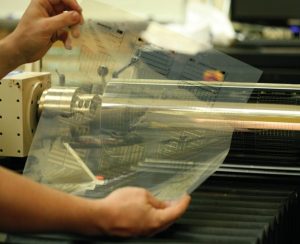
Source: Courtesy of PARC, a Xerox company; (http://gigaom.com/2013/08/20/nasa-wants-to-print-a-spacecraft-but-first-its-printing-the-electronics/).
When considering manufacturing on planets, the availability of construction materials in space on asteroids or surfaces of planets allows one to use manufacturing processes to build settlements without having to launch expensive and prefabricated materials out of Earth’s orbit (Stewart et al. 2022). Lunar regolith (simulated moon soil) could be used to construct pressurized habitats or other infrastructure needed to live on other planets such as landing pads, roads, walls, buildings for protection against thermal radiation on the Moon (Figure 4-13).
Figure 4-13 A robot on the Moon using “contour crafting” to build up a structure, layer by layer

Source: Courtesy of USC.
Contour crafting can create landing pads on the Moon using simulated lunar regolith. Simulated lunar regolith is being manufactured at the University of Central Florida’s Center for Lunar and Asteroid Surface Science (https://sciences.ucf.edu/class/exolithlab/#:~:text=Located%20in%20Orlando%2C%20Florida%2C%20Exolith,asteroid%20regolith%20(soil)%20simulants) and aims to practice building structures on Earth prior to building on the Moon. Contour crafting extrudes a building material layer-by-layer to build structures. ESA has developed a similar technology called D-Shape Printing to build Moon-based habitats (https://www.esa.int/ESA_Multimedia/Images/2013/01/D-Shape_printer).
Launch vehicles transporting materials for additive manufacturing activities in space can provide volume densities > 100 x, producing spacecraft in orbit or in a space-based manufacturing center tailored to operate in a microgravity environment such as the Moon. However, there are still many challenges and hurdles to overcome to realize the concept of manufacturing in space.
Challenges of Manufacturing in Space
For homogenous and heterogeneous material mixtures used in space, new physics-based models of manufacturing processes are required to predict material properties and design the correct material compositions (Owens et al. 2016). An understanding of basic physics will create predictive modeling techniques that will allow engineers to know functional properties of systems of parts (Figure 4-14).
New methods are needed for in-process monitoring and closed-loop feedback of sensors enabling non-destructive evaluation and defect detection. Also, different processing approaches can change the properties of systems due to thermal effects depending on the energy source, density, and environment (Owens 2017).
Figure 4-14 SuperDraco rocket engine uses an additively manufactured Inconel thrust chamber
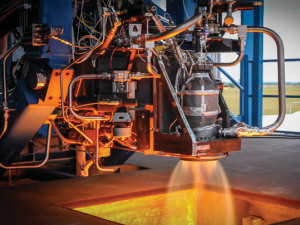
Source: Courtesy of SpaceX.
Printers create parts by fusing solid sheets or by using a laser to heat and/or polymerize. The total volume required to print dominates the build time. The time to print an object also depends on the resolution. The complexity of the design and the application of the part will affect time required to manufacture it. CubeSats can be constructed in weeks if printing is required for complex subsystems. Printing in space will require less mass due to the reduced gravity but is difficult to predict build time without knowing the resolution required and the impact of environment on the process (Prater et al. 2018).
The manufacturing of complex, multi-material, and multi-functional parts involving embedding a circuit board, motor, or other sub-assembly into the process when and where it needs to be integrated can be done easily for ground-based systems. To manufacture a functional satellite in orbit it is likely to require research into additive manufacturing specifically focused on that function and the environment it operates (Figure 4-15).
Figure 4-15 Lockheed Martin’s Advanced Extremely High Frequency Communications Satellite manufactured with additive processes on the Earth

Source: Courtesy of Lockheed Martin Corporation.
Manufacturing spacecraft on Earth through the use of additive manufacturing process requires developments in each of the spacecraft subsystem areas (Prater 2019). Developments in electronics and optical manufacture will require mirrors and optics to be fabricated using photolithographic and surface science techniques that will be more accurate than additive manufacturing processes (Cooper and Griffin 2003). This will require transitioning all types of manufacturing processes to the space environment.
Manufacturing in space can be conducted in a pressurized and climate-controlled environment or provided in an unpressurized vacuum of space. The location of the manufacturing will be affected by the microgravity environment will be a concern and the vacuum and thermal environment will need to be considered when understanding the physics of additive manufacturing processes such as casting, welding, and printing. Electron beam processing has been developed for use in high vacuum environments. It is an energy source that can be adapted to melt and fuse materials and could be useful in the space environment (Bagwell 2018).
The current technologies used on Earth that thrive in vacuum will require further study to understand the effect of zero-gravity or microgravity on manufacturing processes and the properties of the manufactured article (Cooper and Griffin 2003). In the absence of gravity, surface tension forces become dominant forces of system function and processes that rely on the control of fluid or flow conditions will need further understanding. Reduced gravity environments will affect processing parameters and functional integrity of the manufacturing item or system (Marsh 2018).
The lack of gravity will affect the design of handling and support systems for products. Earth based processes all function at 1g within thermally controlled environments. Also, zero/micro gravity environments generate floating debris that has the potential to interfere with the manufacturing process (Moraguez et alia 2019). However, new drives will have to be designed to avoid debris damage and to integrate robotic interactions with manufacturing processes in the absence of gravity to constrain manufactured parts/systems. Microgravity environments might create new opportunities for improving manufacturing systems and processes (Moraguez et alia 2019).
Thermal environments in space include a lack of convection currents that will affect the processes of manufacturing that will be subjected to the thermal loads of solar, albedo (measure of the diffuse reflection of solar radiation out of total solar radiation), and the Earth’s infrared during orbit (Kurk 2017). The operation and performance of manufacturing systems including dimensional accuracy of the product/system will be affected. Shielding may have to be of paramount importance for such operations in space (Huebner 2018).
The creation of stable in-space manufacturing platform is needed to survive and operate in the space environment. The ISS provides a platform for the development of manufacturing processes in a space-based environment. ISS also has a materials science aspect that allows physics-based manufacturing to take place and can be validated too (Norfolk 2018). Clearly, the existence of the ISS is important to the further development of manufacturing in space, but a lunar manufacturing base would provide the economies of scale needed to explore and mine ores on planets such as Mars.
Manufacturing in space is far more of a systems engineering issue compared to manufacturing on Earth (Boling 2019). The supporting infrastructure and environments are not trivial in space compared to Earth and there is a much greater reliance on reusing, recycling, and remanufacturing scarce resources. The circular economy is considered vital to developing any manufacturing system in space and its importance on Earth and in space cannot be overstressed.
Manufacturing in Space and the Circular Economy
Circular versus linear economic model
The current linear consumption model practiced on Earth is one of raw material extraction, production, use, and disposal dominates the global economy. Today, we clearly see that this linear model has led to serious unintended global consequences from resource depletion to global waste, spanning all industrial sectors, from plastics to the built environment. In the current linear economic model, we take, make, and waste products. In contrast with the ‘take-make-waste’ or linear model is the circular economy. The ideas behind the circular economy include keeping products in use, eliminating waste and pollution by design, and aiming to help nature.
In some industries, such as automobile production and commodity aluminum products, circular design principles have been successfully introduced, while in others such as plastics products or the built environment, progress towards circularity has been painfully slow. For example, the growth in the construction sector to house our growing population leads to extraction of construction minerals exceeding 10 billion metric tons annually, and the construction industry alone could be responsible for up to 60% of the remaining carbon budget (Muller, 2013). This industry currently favors the use of products such as composite wood materials that do not degrade such that 38 million tons are landfilled annually in the US alone (U.S. EPA, 2015; Fischer-Kowalski, 2011). In contrast to linear models, circular economy (CE) aims to decouple economic growth from resource consumption by cycling products and materials back into production, either by returning materials to generate new products, or by releasing benign substances to the environment through degradation. CE principles are based on the efficient use of resources and eliminating waste from product life cycles; a truly circular economy keeps material in continuous use by design. The overall adoption of CE principles has been incremental at best – especially in the US – because the market fails to account for externalities (i.e., full environmental costs) and owing to a lack of truly circular designs to replace conventional analogs (EMF, 2017). Bocken (2016) states that CE product design is underpinned by closing and slowing resource loops. Closing resource loops involves either creating products and components that can be easily and safely absorbed by the biosphere or creating items that while they cannot be released to the ecosystem, can be easily recycled to high value uses. As such, closing loops involves: (a) design for a biological cycle, (b) design for a technological cycle, and (c) design for disassembly and reassembly. Designing for slowing resource loops includes design for longer life and product life extension. In the design for longer life, one aims to create more robust products with longer viable service lives, while also creating designs to which consumers become emotionally attached. Product life extension can be achieved through several strategies: (a) design for ease of maintenance and repair, (b) design for upgradability and adaptability, (c) design for standardization and compatibility, and (d) design for dis- and re-assembly.
Circular economy versus sustainability
A circular economy, as defined in the Save Our Seas 2.0 Act, refers to an economy that uses a systems-focused approach and involves industrial processes and economic activities that are restorative or regenerative by design, enable resources used in such processes and activities to maintain their highest value for as long as possible, and aim for the elimination of waste through the superior design of materials, products, and systems (including business models). It is a change to the model in which resources are mined, made into products, and then become waste. A circular economy reduces material use, redesigns materials to be less resource intensive, and recaptures “waste” as a resource to manufacture new materials and products.
A framework is developed to present CE in Figure 4-16 that intends to identify and segregate CE from its surrounding ecosystems similar to a framework used by Nobre (2021). The framework, inspired by the 5W1H concept – What, Where, Why, When, Who and How, allows readers to separate the main research objective – “what is CE?” – from “why it is important”, “where it applies to” and “how it can be implemented”. Ellen MacArthur’s ‘Butterfly’ circular economy system diagram in Figure 4-16 illustrates the continuous flow of technical and biological materials through a circular economy. The closed loop paradigm has started to garner even more attention now that the United Nations (UN) has integrated CE practices to achieve its Sustainable Development Goals (SDGs) by 2030.
Figure 4-16 Circular economy definition framework
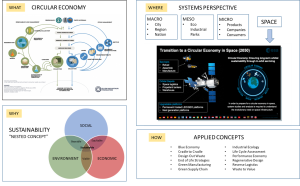
Source: United Nations (UN) has integrated CE practices
While the terms ‘Circular Economy’ and ‘Sustainability’ are increasingly gaining traction with academia, industry, and policymakers, the similarities and differences between both concepts remain ambiguous. The Brundtland Commission provided the most commonly accepted definition of sustainability as “development that meets the needs of the present without compromising the ability of future generations to meet their own needs” (Brundtland, 1987).
The most noticeable work on CE has been by the Ellen MacArthur Foundation. The Foundation acts as a collaborative hub for businesses, policy makers, and academia. The CE concept has gained traction with policymakers, influencing governments and intergovernmental agencies at the local, regional, national, and international level. Germany was a pioneer in integrating the Circular Economy into national laws, as early as 1996, with the enactment of the “Closed Substance Cycle and Waste Management Act” (Su et al., 2013). This was followed by Japan’s 2002 “Basic Law for Establishing a Recycling-Based Society” (METI, 2004), and China’s 2009 “Circular Economy Promotion Law of the People’s Republic of China” (Lieder and Rashid, 2016). Supranational bodies have also incorporated circular economy concerns – most notably the EU’s 2015 Circular Economy Strategy (European Commission, 2015).
The modern understanding of the term Circular Economy seems to have emerged more recently than that of sustainability. While the Circular Economy is traced back by EMF (2013) to different schools of thought like cradle-to-cradle and industrial ecology, the concept of sustainability is considerably older (Mantel, 1990) and was institutionalized by environmental movements and supranational bodies, especially after the publication of the Brundtland report in 1987. Table 1 summarizes the identified differences between the two concepts of Circular Economy and Sustainability.
Applying the circular economy in space
According to a well-known OECD’s definition, the space economy “comprises a long value-added chain, starting with research and development actors and manufacturers of space hardware (e.g., launch vehicles, satellites, ground stations) and ending with the providers of space-enabled products and services to final users” (OECD, 2007, online).
The traditional approach to space industry was to divide the sector into two segments: one upstream, which includes launch systems, ground operations and satellite manufacturers and the other downstream, related to all providers of satellite communication services to the consumers (OECD, 2007). This distinction, which came into existence in the 1990s during the marked increase in the commercialization of satellite services around the world, is still popular, irrespective of the fact that the sector itself has moved on both for turnover and as a paradigm jump. The space industry went through a cycle development, each of which presenting widely different characters and actors (OECD, 2016, 2019). Cycle 4 characterized by both the popularization and the globalization of space has seen the emergence of a different kind of downstream activities, mainly handled by private companies and supported by the on-going digital revolution, has now been completed. The new Cycle 5, started in 2018 and expected to last until 2033, will be determined by an ever-increasing availability of data, and, among other things, by the widespread adoption of CE principles. Cycle 5 is characterized by growing uses of satellite infrastructure outputs; global monitoring; new space activities; and robotics missions (Paladini, 2021).
Paladini et al (2021) propose a framework integrating circular economy, Space Sector, and Industry 4.0. The cornerstone of Industry 4.0 conceptualization mandates that, while its nine innovation-enabler fundamental pillars ((i.e., Big Data & AI, Horizontal &Vertical Integration, Cloud Computing, AR, IoT, Additive Manufacturing and 3D Printing, Autonomous Robot, Simulation, Cyber-Security (Russmann et al., 2015)) make smart systems possible, it is only when they are all used together that Industry 4.0 unleashes all its potential (Sap, 2020; Haskel and Westlake, 2018). Space system Cycle 5, has already brought a series of new actors on the world scene and a different set of procedures at all levels, taking the sector away from the traditional upstream and downstream divide and steering it toward a different configuration, in an increasingly overlapping series of value chains whose potential for spillovers to other sectors are far higher. The adoption of incremental technologies, including data analytics, additive manufacturing, and robotics, had the net effect of reducing those material costs and production times, changing dramatically the way both private and public operators plan their missions. In one of the trends that is certainly going to keep growing is the way private process innovators are changing the sector, followed by the incumbents, especially in additive manufacturing (Russell, 2017; EOS, 2016) already identified as one of the cardinal points of CE applications to industry. Space X’s reusable rockets and adaptation of experiences and data from high-volume industries (Space X, 2021; OECD, 2019), such as the automotive industry, are just the beginning.
Other innovations that have already made their appearance in the area of space manufacturing includes extensive 3D printing (e.g., Space X rockets and RocketLab engines), a growing reliance on ‘off-the-shelf’ components within supply chains, and the Cubesat revolution of low-cost and low-impact satellites, which have become the tool of choice of small organizations and educational institutions.
Applying circular economy principles in space for manufacturing
- Efforts in the US
NASA’s In-Space Manufacturing (ISM) project seeks to develop the materials, processes, and manufacturing technologies needed to provide an on-demand manufacturing capability for deep space exploration missions. The ability to manufacture, repair and recycle some parts on demand rather than launch them from earth has the potential to reduce logistics requirements on long duration missions and enhance crew safety.
ISM can provide on-demand fabrication, repair, and recycling for critical systems, habitats, and mission logistics and maintenance (both in-transit and on-surface). This can provide cost savings by decreasing launch mass. Risk is reduced by decreasing the need for pre-produced spares and/or over-designing systems for reliability. ISM is developing these capabilities by using new technologies being developed terrestrially and modifying them for use in the space environment.
In-Space Manufacturing shows immense potential to achieve gains in logistics reduction by (a) reducing the number of spare parts and orbital replacement units which much be up massed and (b) enabling the recycling of materials which would otherwise be nuisance materials (scrap/trash) or consumables (Owens, 2016; Owens, 2017). The “make it, don’t take it” philosophy represents a fundamental paradigm shift from traditional logistics models, which rely on the change out of orbital replacement units (stowed on the ISS) rather than repair of a unit at the component level. The implementation of ISM on future space mission thus depends on design of exploration systems which are accessible and intended to be repaired rather than simply changed out with an identical full-scale unit stored on-orbit.
The work under the recycling/reuse component of the In-Space Manufacturing portfolio focuses on reuse of plastics and packaging materials through (a) manufacturing technology development for (i) recycling and (ii) printing with recycled materials and (b) development of materials which are intended to be reused and recycled.
- Efforts in the EU
European Space Agency (ESA) is looking to foster the implementation of a ‘circular economy’ in space by recycling, refurbishing, repurposing, and reusing by 2050. In this case, a circular economy means “ensuring long-term orbital sustainability through in-orbit servicing.”
The first step toward these goals has been taken through a series of ESA studies carried out with European industry under the umbrella title of ‘On-Orbit Manufacture, Assembly and Recycling’ (OMAR). These studies identified some key advantages that this revolutionary new space ecosystem could have, including:
- Reduction in launch mass by taking advantage of material, equipment or even entire assets that are already in orbit.
- Reduction in raw materials that are required to be extracted on ground by recycling critical raw materials that are already in orbit.
- Decrease in development times as the assets can be developed and tested directly in orbit.
- Development of key technologies and capabilities that currently cannot be achieved because satellites are constrained by the dimensions and capabilities of launchers.
To transition from OMAR studies to a circular economy, the Agency is considering presenting a proposal at the ESA Ministerial Council (end-2022) to place contract(s) with service provider(s) and customer(s) to perform In-Orbit Servicing covering some or all services listed below:
Cooperative Attitude and Orbit Control System (AOCS) takeover: lifetime extension for a customer spacecraft by providing the needed propulsion/actuation capabilities.
Assembly: Assemble, manipulate and/or disassemble (take apart) spacecraft parts from or into a satellite/vehicle.
Refurbishment: Rehabilitation or servicing of a spacecraft by replacing current aged or non-functional parts by new, equivalent ones.
Manufacturing: Manufacturing of spacecraft parts in orbit starting from raw material and/or basic components coming from Earth and/or from in-orbit recycling.
Refueling: Re-supply of propellant to a spacecraft already in space.
Future Possibilities
The future possibilities associated with manufacturing in space are tremendous and varied including planetary mining and manufacturing, asteroid mining and manufacturing, and manufacturing in orbit around planets and satellites of planets. The challenges are great and a great deal of understanding the physics of manufacturing processes is needed in addition to the integration of systems to minimize waste and effort. The space environment allows us to develop materials that cannot be made on Earth owing to gravity or environmental constraints. There is a vast amount of knowledge that we simply do not know about manufacturing in space environments that will occupy the minds of young scientists and engineers for decades to come.
Questions
- Describe the concept of ‘manufacturing in space’.
- How does the microgravity environments affect the structure of materials and how they are manufactured into parts, components, systems, and sub-systems?
- What are manufacturing standards and how are they harmonized?
- Describe the type of equipment used on the International Space Station (ISS) to study the effects of microgravity on the properties of materials.
- How does ‘Circular Economy’ fit into the concept of sustainability?
- What are the three pillars of sustainability? What happens when only two out of the three pillars are achieved?
- How is circularity applied in the space sector?
- Compare and contrast the US’s and the EU’s circularity efforts in the area of manufacturing in space.
- Why is manufacturing in space different to manufacturing on Earth? Compare and contrast the differences.
- Why is the application of systems engineering principles critical to manufacturing in space?
References
“Acoustical Signature Analysis for In-Situ Monitoring and Quality Control for In-Space
Manufacturing.” MetroLaser, Inc. Small Business Innovative Research (SBIR) abstract. 2018. < https://www.sbir.gov/sbirsearch/detail/1559789>
AM Sub-Platform, 2013 Additive Manufacturing: Strategic Research Agenda, Version 2, http://www.rm-platform.com/linkdoc/AM_SRA_ FINAL-V2.pdf.
Anderson, Janet. “NASA to Demonstrate Refabricator to Recycle, Reuse, Repeat.” NASA Press Release. 14 November 2018. < https://www.nasa.gov/mission_pages/centers/marshal l/images/refabricator.html>
Bagwell, Roger. “Additive Manufacturing of PEEK and Fiber-Reinforced PEEK for NASA Applications and Custom Medical Devices.” Proceedings of the National Space and Missile Materials Symposium, Henderson, NV. June 2018.
“Automated In-Process Quality Control of Recycled Filament Production and FDM Printers.” Cornerstone Research Group. Small Business Innovative Research (SBIR) abstract. 2018. < https://www.sbir.gov/sbirsearch/detail/1559745>
Bhundiya, H.G., Royer, F. & Cordero, Z. Engineering Framework for Assessing Materials and Processes for In-Space Manufacturing. J. of Materials Eng and Perform, 2022, 31, 6045–6059. https://doi.org/10.1007/s11665-022-06755-y
Bocken, N.M.P., de Pauw, I., Bakker, C., van der Grintern, B., Product design and business model strategies for a circular economy. J. Industr. Prod. Eng., 2016. 33(5): p. 308-320.
Boling, Rich. “3D Printer for Human Tissue Now Available for Research Onboard the ISS National Laboratory.” ISS National Lab. 13 August 2019. < https://www.issnationallab.org/blog/3d-printer-for-human-tissue-now-available-for-research-onboard-the-iss-national-laboratory/>
Brundtland, G.H., 1987. Our common future: Report of the 1987 World Commission on Environment and Development. United Nations, Oslo.
Brussels. Lieder, M., Rashid, A. Towards circular economy implementation: a comprehensive review in context of manufacturing industry, 2016, J. Clean. Prod. 115, 36–51.
“CRISSP Custom Recyclable International Space Station Packaging.” Small Business Innovative Research (SBIR) abstract. 2017. www.sbir.gov/sbirsearch/detail/1148879
Cooper K. and Griffin M., Microgravity Manufacturing Via Fused Deposition, NASA TM-2003-212636 (https://ntrs.nasa.gov/citations/20030067856).
Ellen MacArthur Foundation (EMF), 2013. Towards the Circular Economy, vol.1. Isle of Wight.
Ellen MacArthur Foundation. Barriers policy can overcome. 2017 (cited 9 August 2022).
European Powder Metallurgy Association, “European Additive Manufacturing Group (EAMG),” http://www.epma.com/european- additive-manufacturing-group, accessed March 11, 2014
European Commission. Closing the loop – An EU action plan for the Circular Economy, Com (2015) 614 communication from the commission to the European parliament, the council, the European economic and social committee, and the committee of the regions.
“Feedback Sensors for Closed Loop In-Space Manufacturing.” Cybernet Systems Corporation. Small Business Innovative Research (SBIR) abstract. 2018. < https://www.sbir.gov/sbirsearch/detail/1559783>
Fischer-Kowalski, M., et al., “Methodology and Indicators of Economy-wide Material Flow Accounting”. 2011. 15(6): p. 855-876.
Geissdoerfer, M. and Savaget, P. and Bocken, N.M.P. and Hultink, E.J. The circular economy – a new sustainability paradigm? Journal of Cleaner Production., 2017, 143. pp. 757-768.
Gradl, P., Tinker, D.C., Park, A. et al. Robust Metal Additive Manufacturing Process Selection and Development for Aerospace Components. J. of Materials Eng and Perform, 2022, 31, 6013–6044. https://doi.org/10.1007/s11665-022-06850-0
Haskel, J., Westlake, S., 2018. Capitalism without Capital: the Rise of the Intangible Economy. Princeton University Press, Princeton, New Jersey
Hofmann D., Borgonia J., Dillon D., Suh E., Mulder J., and Gardner P., “Applications for Gradient Metal Alloys Fabricated Using Additive Manufacturing,” NASA Technical Brief, Jet Propulsion Laboratory, October 1, 2013, http://www.techbriefs.com/component/ content/article/17446.
Huebner, Lawrence. “Archinaut Technology Development: Ground-Based Results for External In-Space Additive Manufacturing and Assembly.” Proceedings of the National Space and Missile Materials Symposium, Henderson, NV. June 2018.
“In-Space Manufacturing (ISM) Multi-material Fabrication Laboratory (FabLab).” Broad Agency Announcement. 11 April 2017. www.fbo.gov/index?s=opportunity&mode=form&tab=core&id=8a6ebb526d8bf8fb9c6361cb8b50c1f8&_c view=1
“In Situ Monitoring and Process Control.” Made in Space. Small Business Innovative Research (SBIR) abstract. 2018. < https://www.sbir.gov/sbirsearch/detail/1559743>
“In Situ Monitoring of In-Space Manufacturing by Multi-Parameter Imaging.” LER Technologies. Small Business Innovative Research (SBIR) abstract. 2018. https://www.sbir.gov/sbirsearch/detail/1559833>
Kim, H. Wu, D.I. Moon, M.L. Seol, B. Kim, D.I. Lee, J.W. Han, and M. Meyyappan. “Carbon nanotube Based Gamma Ray Detector.” ACS Sensors. Volume 4, 2019, pp. 1097-1102.
Korkut, V., Yavuz, H. In-Space Additive Manufacturing Based on Metal Droplet Generation Using Drop-on-Demand Technique. J. of Materials Eng and Perform, 2022, 31, 6101–6111. https://doi.org/10.1007/s11665-022-06865-7
Kovalchuk, D., Melnyk, V. & Melnyk, I. A Coaxial Wire-Feed Additive Manufacturing of Metal Components Using a Profile Electron Beam in Space Application. J. of Materials Eng and Perform, 2022, 31, 6069–6082. https://doi.org/10.1007/s11665-022-06994-z
Kurk, Andy. “Sintered Inductive Metal Printer with Laser Enhancement.” Proceedings of the National Space and Missile Materials Symposium, Palm Springs, CA. June 2017.
Mantel, K., 1990. Wald und Forst in der Geschichte. M. & H. Schaper, Hannover.
Marsh, Doug. “The VULCAN Advanced Hybrid Manufacturing System.” Proceedings of the National Space and Missile Materials Symposium, Henderson, NV. June 2018.
METI, 2004. Handbook on Resource Recycling Legislation and 3R Initiatives. Tokyo: Japanese Ministry of Economy, Trade, and Industry.
Momeni, K., Neshani, S., Uba, C. et al. Engineering the Surface Melt for In-Space Manufacturing of Aluminum Parts. J. of Materials Eng and Perform, 2022, 31, 6092–6100. https://doi.org/10.1007/s11665-022-07054-2
Moraguez, M., O. DeWeck, and T. Prater.“Suitability of Manufacturing Processes for In-Space Manufacturing of Spacecraft Components.” Proceedings of the 70th International Astronautical Congress, Washington, D.C. 2019.
Muhlbauer, Rachel. “Food-safe, skin contact-safe, and medical device 3D printing for manned space missions.” Proceedings of the National Space and Missile Materials Symposium, Palm Springs, CA. June 2017.
Muhlbauer, Rachel. “Metal Advanced Manufacturing Bot Assembly (MAMBA) Process.” Small Business Innovative Research (SBIR) abstract. 2017. http://sbir.nasa.gov/SBIR/abstracts/17/sbir/phase1/SB IR-17-1- H7.02-9710.html
Müller, D.B., et al., Carbon Emissions of Infrastructure Development. Environmental Science & Technology, 2013. 47(20): p. 11739-11746.
Munther, D.I. Moon, B. Kim, J.W. Han, K. Davami, and M. Meyyappan, “Array of Chemiresistors for Single Input Multiple Output (SIMO) Variation-Tolerant All Printed Gas Sensor” Sensors and Actuators, Volume 299 pp. 1269-71. 2019.
Nafisi, S., Hofmann, D., Gradl, P. et al. Space and Aerospace Exploration Revolution: Metal Additive Manufacturing. J. of Materials Eng and Perform, 2022, 31, 6011–6012. https://doi.org/10.1007/s11665-022-06929-8
Nobre, G. C., Tavares, E. The quest for a circular economy final definition: A scientific perspective, Journal of Cleaner Production, Volume 314, 2021.
Norfolk, Mark. “Solid State Metal Manufacturing for International Space Station (ISS).”, Proceedings of the National Space and Missile Materials Symposium, Henderson, NV. June 2018.
NRC, Microgravity Research in Support of Technologies for the Human Exploration and Development of Space and Planetary Bodies, National Academy Press, Washington, D.C., 2000, pp. 99-100.
OECD, 2007. The Space Economy at a Glance. OECD, Paris.
OECD, 2016. Space and Innovation. OECD, Paris.
OECD, 2019. The Space Economy in Figures: How Space Contributes to the Global Economy. OECD, Paris.
Owens, A., O. C. de Weck, W. Stromgren, W. Cirillo, and K. Goodliff. “Supportability Challenges, Metrics, and Key Decisions for Human Spaceflight.”Proceedings of the American Institute of Aeronautics and Astronautics (AIAA) SPACE Forum, Orlando, FL, 2017.
Owens, A., and O. DeWeck. “Systems Analysis of In-Space Manufacturing Applications for International Space Station in Support of the Evolvable Mars Campaign.” Proceedings of the American Institute of Aeronautics and Astronautics SPACE Forum, Long Beach, CA. 2016.
Paladini, S., Saha, K., Pierron, X., Sustainable space for a sustainable earth? Circular economy insights from the space sector. Journal of Environmental Management 289, 2021, 112511.
Patankar, Sunil. “Development of Fiber-Reinforced Composite Feedstock for In-Space Manufacturing of High Strength Parts.” Proceedings 70th International Astronautical Congress (IAC), Washington, D.C., 21-25 October 2019 of the National Space and Missile Materials Symposium, Henderson, NV. June 2018.
Prater, T., N. Werkheiser, F. Ledbetter, D. Timucin, K. Wheeler, M. Snyder. “3D Printing in Zero G Technology Demonstration Mission: complete experimental results and summary of related materials modeling efforts.” The International Journal of Advanced Manufacturing Technology. Volume 101 (2019): pp. 391-417.
Prater, T., N. Werkheiser, F. Ledbetter, and K. Morgan. “In-Space Manufacturing at NASA Marshall Space Flight Center: A Portfolio of Fabrication and Recycling Technology Development for the International Space Station.” Proceedings of the AIAA SPACE Forum, Orlando, FL, 2018.
Prater T., et al., “NASA’s In-Space Manufacturing Project: Update on Manufacturing Technologies and Materials to Enable More Sustainable and Safer Exploration”, Proceedings 70th International Astronautical Congress (IAC), Washington, D.C., 21-25 October 2019. IAC-19.D3.2B.5.
Riissmann, M., Lorenz, M., Gerbert, P., Waldner, M., Justus, J., Engel, P., Harnisch, M., 2015. Industry 4.0: the Future of Productivity and Growth in Manufacturing Industries. Consulting Group, Boston, pp. 1-14.
Russell, K., 2017. Thales Alenia Space Saves Time, Money with 3D Printing, Satellite. https://www.satellitetoday.com/innovation/2017/06/27/3d-printing-future-satellite-manufacturing/. (cited 22 July 2022).
SAP, 2020. SAP Insights. What ls Industry 4.0? Definition, Technologies, Benefits.
https://insights.sap.com/what-is-industry-4-0/. (cited 5August 2022).
Schmuland D., Carpenter C., Masse R., and Overly, J., “New Insights into Additive Manufacturing Processes: Enabling Low-Cost, High- Impulse Propulsion Systems,” 27th Annual AIAA/USU Conference on Small Satellites, AIAA Paper SSC13-VII-4, 2013, American Institute of Aeronautics and Astronautics, Reston, Va.
Stewart, B.C., Doude, H.R., Mujahid, S. et al. Novel Selective Laser Printing Via Powder Bed Fusion of Ionic Liquid Harvested Iron for Martian Additive Manufacturing. J. of Materials Eng and Perform, 2022, 31, 6060–6068. https://doi.org/10.1007/s11665-022-06730-7
Su, B., Heshmati, A., Geng, Y., Yu, X., 2013. A review of the circular economy in China: moving from rhetoric to implementation. J. Clean. Prod. 42, 215–227.
SpaceX, 2022. SpaceX Homepage. https://www.spacex.com/. (cited 22 July 2022).
U.S. EPA. “Advancing Sustainable Materials Management: 2015 Fact Sheet”. 2018.
Volz, Martin, “Materials Science in Microgravity”, 3rd Annual ISS Research and Development Conference Chicago, Illinois, June 17-19, 2014.
Warner, Cheryl. “NASA Selects Three Companies to Develop ‘FabLab’ Prototypes.” NASA Press Release. 7 December 2017. www.nasa.gov/press-release/nas-selects-three-companies-to-develop-fablab-prototypes.

